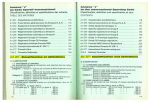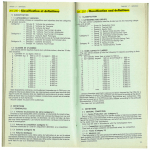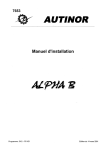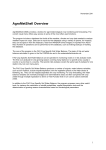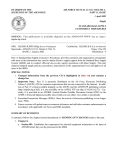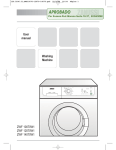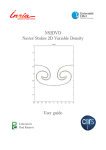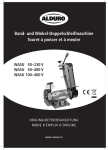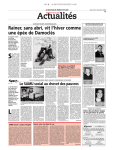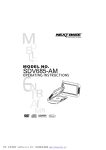Download annexe "J" annexe "à"
Transcript
annexe "J"
annexe "à"
au Code Sportif international
Classification , définition et spécifications des voitures
TABLE DES MATIÈRES
to the International Sporting Code
Classification , definition and specification of cars
CONTENTS
Art 251 - Classification et définitions ...................... 118
Art 252 - Prescriptions générales pour les Groupes N, A, B .... 130
Art 251 - Classification and definitions .................... 119
Art 253 - Equipement de sécurité ( Catégorie 1 ) .............. 136
Art 254 - Réglementation spécifique au Groupe N ........... 156
Art 255 - Règlementation spécifique au Groupe A ........... 162
Art 256 - Règlementation spécifique au Groupe B ........... 180
Art 253 - Safety equipment ( Category 1) .................... 137
Art 252 - General prescriptions for Groups N, A, B ........... 131
Art 254 - Specific regulations for Group N .................. 157
Art 255 - Specific regulations for Group A .................. 163
Art 256 - Specific regulations for Group B .................. 179
Art 257 - Règlement Groupe Cl Prototype .................. 182
Art 258 - Règlement Groupe C2 Prototype .................. 202
Art 274 - Règlement technique Formule 3000 ............... 204
Art 257 - Group Ci Prototype regulations ..................
Art 275 - Formule Internationale N° 21N° 3 ................. 226
Art 277 - Formule Libre .................................. 252
Titre 5 - Formules Nationales ........................... 254
Art 275 - International Formula N ° 21N° 3 .................. 229
Art. 251 - Classification et définitions
Art. 251 - Classification and deflnitions
1) CLASSIFICATION
1) CLASSIFICATION
1.1) CATÉGORIES ET GROUPES
Les automobiles utilisées en compétition sont réparties dans les catégories et groupes suivants:
Catégorie l : Groupe N: Voitures de Tourisme de Série de grande production.
Groupe A : Voitures de Tourisme de grande production.
Groupe B : Voitures de Grand Tourisme.
Catégorie Il Groupe C : Voiture de Sport.
Groupe D : Voitures de Course de Formule Internationale.
Groupe L : Voitures de Course de Formule Libre.
1.2) CLASSES DE CYLINDRÉE
Les voitures seront réparties d'après leur cylindrée-moteur, dans les 15
classes suivantes :
1. Cylindrée inf. ou égale à 500 cc
500 cc et inf. ou égale à 600 cc
2. Cylindrée sup. à
700 cc
600 cc
3.
"
850 cc
700 cc
" "
4.
1,000 cc
850 cc
" "
5.
"
1.150 cc
1.000 cc
" "
"
"
6.
1.1) CATEGORIES AND GROUPS
The cars used in competition shall be divided up into the following categories and groups:
Category I : Group N: Large scale séries production touring cars.
Group A: Large scale production.
Group B: Series-production grand touring cars.
Category Il: Group C :Sports cars.
Group D: International Formula racing cars.
Group E: Formula libre racing cars.
1.2) CUBIC CAPACITY CLASSES
The cars will be divided up into following 15 classes according to their
cubic capacity.
1. Cylinder-capacity lower than or equal te 500 cc
2. Cylinder-capacity exceed. 500 cc and louver thanlequal to 600 cc
3.
"
"
600 cc
" " "
700 cc
4.
700 cc
850 cc
5.
"
"
850 cc
" " "
1,000 cc
6.
"
"
1,000 cc
1,150 cc
118
181
Art 258 - Group C2 Prototype regulations .................. 201
Art 274 • Formula 3000 Technical Régulations .............. 203
Art 277 - International Formulae racing cars ................ 251
Titre 5 - National Formulae . 1 . .. . . . . . .. . .. . . .. . . . . . . . . . . . 253
1
119
Annexe "J
7.
8,
9.
10.
11.
12.
13.
14.
15.
Aooend:x °J q ehnnioas
1,300 cc
1,150 cc
1,600 cc
1,300 cc
"
2,000 cc
"
1,600 cc
2,500 cc
2.000 cc
3,000 cc
2,500 cc
4,000 cc
3.000 cc
5,000 cc
4,000 cc
6,000 cc
5.000 cc
6,000
cc
" over
"
15.
Unless otherwise specified in special provisions imposed by the FIA for a
certain category of events, the organisera are bound to include ail the abovementioned classes in the Supplementary Regulations and, furthermore, they
are free to group Iwo or more consecutive classes, according to the particular circumstances of their avents,
No class be subdivised.
Définitions
"
"
"
"
"
"
"
"
"
"
"
"
"
1.150 cc
1.300 cc
1.600 cc
2.000 cc
2.500 cc
3.000 cc
4.000 cc
5.000 cc
6.000 cc
"
"
"
"
"
"
"
"
"
7.
8.
9.
1,300 cc
1.600 cc
2.000 cc
2.500 cc
3.000 cc
4.000 cc
5.000 cc
6.000 cc
Sauf dispositions contraires, éventuellement imposées par la FIA pour une
catégorie d'épreuves déterminée, les organisateurs ne sont pas tenus de
faire figurer toutes les classes dans les règlements particuliers et de plus,
restent libres de réunir deux ou plusieurs classes consécutives suivants les
circonstances propres à leurs épreuves.
Aucune classe ne pourra être subdivisée.
2) DEFINITIONS
2.1) GÉNÉRALITÉS
2,1.1) Voitures de production ( catégorie I) :
Voitures au sujet desquelles a été constatée, à la demande du constructeur, la fabrication en série d'un certain nombre de voitures identiques (voir
ce mot) dans une période de temps donnée, et destinées à la vente normale à
la clientèle (voir cette expression).
2.1.2) Voitures de compétition ( catégorie Ii):
Voitures construites à l'unité et uniquement destinées à la compétition,
2.1.3) Voitures identiques :
Voitures appartenant à une môme série de fabrication et qui ont la même
carrosserie (extérieure et intérieure), les mêmes parties mécaniques et le
même châssis (étant entendu que ce châssis peut être partie intégrante de la
carrosserie dans le cas d'un ensemble monocoque).
2.1.4) Modèle de voiture:
Voiture appartenant à une série de fabrication qui se distingue par une
conception et une ligne extérieure déterminées de la carrosserie, et par une
même exécution mécanique du moteur et de l'entraînement des roues.
2.1.5) Vente normale:
li s'agit d'une distribution à la clientèle particulière parle service commercial du constructeur.
2.1.6) Homologation :
C'est la constatation officielle faite par la FIAIFISA qu'un modèle de voiture déterminé est construit en série suffisante pour être classée dans les
Groupes N et A, ou S du présent règlement. La demande d'homologation doit
être présentée à la FIAIFISA par l'ASN du pays de construction du véhicule et
donner lieu à l'établissement d'une fiche d'homologation (voir ci-après).
Elle doit être faite en conformité avec un règlement spécial dit "règlement
d'homologation" établi par la FIAIFISA.
Toute homologation d'un modèle construit en série devient caduque 5 ans
après l'abandon définitif de la construction en série dudit modèle (production annuelle inférieure à 10 % du minimum de production du groupe considéré).
L'homologation d'un modèle ne peut être valable que dans un seul groupe.
120
"
"
"
"
2) DEFINITIONS
2,1) GENERAL CONDITIONS
2.1.1) Production cars ( Category I):
Cars of which the production of a certain number of identical examples
(see detinition of this word hereinafter) within a certain period of time has
been verified ai the requesi of the manufacturer, and which are destined for
normal sale to the public (see this expression).
2.1.2) Competitions cars (Category II) :
Cars built as single examples and destined solely for competition.
2.1.3) Identical cars:
Cars belonging to the same production series and which have the saure
bodywork (outside and inside). saine mechanical components and same
chassis (everi though this chassis may be an integral part of the bodywork in
case of a monocoque construction).
2.1.4) Model of car:
Car belonging to a production-series distinguishable by specific conception and extemal general lines of the bodywork and by an identical mechanical construction of the angine and the transrnission to the wheels.
2.1,5) Normal sale:
Means the distribution of cars to individual purchasers through the normal
commercial charnels of the manufacturer.
2.1.6) Homologation:
Is the official certification made by the FIAIFISA that a minimum riumbers
of cars a specific modal has been made on series-production terme to justify
classification in Groups N. A or B of these regulations. Application for homologation shah De submitted to the FIAIFISA by the ASN of the country in
which the vehicule is manufactured and shah entai) the drawing up of a
homologation form (see below). If must be established in accordante with
the special regulations called "Regulations for homologation", laid down by
the FIAIFISA. Homologation of a series-produced car will become nul) and
void 5 years alter the date which the series-production of the said model has
been stopped (series-production under 10 % of the minimum production of
the group considered).
The homologation of a model can only be valid in one group. AIN or B. If a
1
121
1
il
Annexe "J"- Définitions
AppenrJ x "J"- Definitions
mode) already homologated in Group B passes into Group AIN, the Group B
homologation is cancelled.
AIN ou B. Le passage en Groupe AIN d'un modèle déjà homologué en Groupe
B annule l'effet de la première homologation.
2.1.7) Fiches d'homologation :
Tout modèle de voiture homologué par la FIAIFISA fait l'objet d'une fiche
descriptive dite fiche d'homologation, sur laquelle sont indiquées les caractéristiques permettant d'identifier ledit modèle.
Cette fiche d'homologation définit la série telle que l'indique le constructeur. Selon le groupe dans lequel courent les concurrents, les limites des
modifications autorisées en compétition internationale par rapport à cette
série, sont indiquées par l'Annexe J.
La présentation des fiches au contrôle de vérification et/ou avant le départ
pourra être exigée par les organisateurs qui seront en droit de refuser la participation du concurrent en cas de non-présentation.
En ce qui concerne le Groupe N, outre la fiche spécifique à ce groupe, on
devra également présenter la fiche Groupe A (ou le transfert FISA en Groupe
A).
Au cas oit la comparaison d'un modèle de voiture avec sa fiche d'homologation laisserait subsister un doute quelconque, les commissaires techniques devraient se référer au manuel d'entretien édité à l'usage des concessionnaires de la marque ou bien au catalogue général comportant la liste des
pièces de rechange.
Au cas où cette documentation ne se révèlerait pas suffisamment précise,
il sera possible d'effectuer des vérifications directes par comparaison avec
une pièce disponible, chez un concessionnaire.
Il appartient au concurrent de se procurer la fiche d'homologation concernant sa voiture, auprès de l'ASN du pays de construction de son véhicule, ou
auprès de la FIAIFISA.
Description : Une fiche se décompose de la façon suivante :
1) Une fiche de base décrivant le modèle de base.
2) Eventuellement un certain nombre de feuilles supplémentaires décrivant des extensions d'homologation qui peuvent être des "variantes", des
"errata" ou des "évolutions".
a) Variantes (VIF, VO)
Ce sont soit des variantes de fournitures (VF) (2 fournisseurs livrent au
constructeur une même pièce et le client n'est pas en mesure de choisir), soit
des options (VO) (livrables sur demande et disponibles chez les concessionnaires).
b) Erratum (ER)
Il remplace et annule un renseignement erroné fourni précédemment par le
constructeur sur une fiche,
c) Evolution (ET)
Caractérise des modifications apportées à litre définitif au modèle de
base (abandon complet de la fabrication du modèle sous son ancienne
forme).
Utilisation
1) Variantes (VF, VO)
Le concurrent ne peut utiliser toute variante ou tout article d'une variante,
à sa convenance, qu'à la condition que toutes les données techniques du
véhicule ainsi conçu se trouvent conformes à celles qui sont décrites dans la
fiche d'homologation applicable à la voiture, ou expressément autorisées
par l'annexe J. Par exemple, le montage d'un étrier de frein défini sur une
2.1.7) Homologation forms:
All cars recognised by the FIAIFISA shall be the subject of descriptive
form called homologation form on which shall be entered ail data enabling
identification of the eaid model.
This homologation form dolines the sertes as indicated by the manufacturer. According ta the group in which the competitors race, the modification
limits allowed in international competition for the series are stated in Appedix J.
The presentation of the forms al scrutineering andlor al the start may be
required by the organisers who will be entitled ta refuse the participation of
the entrant in the event in case of non-presentation.
With regard ta Group N, apart from the specific form for this group, the
Group A form must also be submitted (or the FISA transfer ta Group A).
In case of any doubt remaining alter the checking of a mode) of car against
its homologation form, the scrutineers should refer either ta the maintenance
booklef published for the use of the make's distributors or ta the general
catalogue in which are listed all spare parts.
In case of lack of enough accurate documentation, scrutineers may carry
out direct scrutineering by comparaison with an identical part available from
a concessionnaire. Il will be up ta the competitor tu obtain the homologation
concerning his car from the ASN of the manufacturing country of the vehicule, or from the FIAIFISA.
Description . A form breaks down in the following way:
1) A basic form giving a description of the basic model.
2) At a later stage, a certain number of additional sheets describing
"homologation extensions", which can rie "variants", or "errata" or "evolufions" ,
a) Variants (VF, VO)
These are either supply variants (VF) (two suppliers providing the same
part for the manufacturer and the client cotas not have the possibility of
choice), or options (VO) (suppliedon request and available al the concessionnaires).
b) Erratum (ER)
Replaces and cancels an incorrect piece of information previously supplied by the constructor on a form.
c) Evolution (ET)
Characterised by modifications made on a permanent basis ta the basic
model (complete cessation of the production of the car in its original form).
Use
1) Variants (VF, VO)
The competitor may use any variant as he wishes, only on condition that
ail the technical data of the vehicle, so designed, conforms ta that described
on the homologation form applicable ta the car, or expressly allowed by
Appendix J.
For example, the fitting of a brake calliper as defined on a variant form is
only possible if the braking surface. the dimensions of the brake linings, etc.
obtained in this way, are indicated on a form applicable ta the car in question. (For Group N, sec also Art. 254.2).
123
122
1
fil
Annexe "J"- Définitions
fiche variante n'est possible que si la surface de freinage, les dimensions
des garnitures, etc. ainsi obtenues se trouvent indiquées sur une fiche applicable à la voiture concernée (Voir aussi Art. 254.2 pour le Groupe N),
2) Evolution (ET)
(Voir aussi Art. 254.2 pour le Groupe N).
La voiture doit correspondre à un stade d'évolution donné (indépendamment de sa date réelle de sortie d'usine), et donc une évolution doit être appliquée intégralement ou ne pas l'être du tout. En outre, à partir du moment où
le concurrent aura choisi une évolution particulière, toutes les évolutions
précédentes doivent également être appliquées, sauf s'il y a incompatibilité
entre elles : par exemple, si deux évolutions sur les freins ont lieu successivement, on utilisera uniquement celle correspondant par la date au stade
d'évolution de la voiture,
Cette fiche d'homologation définit la série telle que l'indique le constructeur. Selon le groupe dans lequel courent les concurrents, les limites des
modifications autorisées en compétition internationale. par rapport à cette
série, sont indiquées par l'Annexe J.
2.1.8) Parties mécaniques
Toutes celles nécessaires à la propulsion, la suspension, la direction et le
freinage. ainsi que tous accessoires mobiles ou non qui sont nécessaires à
leur fonctionnement normal.
2.2) DIMENSIONS
Périmètre de la voiture vue du dessus :
Il s'agit de la voiture telle que présentée sur la grille de départ, pour
l'épreuve considérée.
2.3) MOTEUR
2.3.1) Cylindrée : Volume engendré dans le ou les cylindres moteurs par le
déplacement ascendant ou descendant du ou des pistons.
Pour tous les calculs concernant la cylindrée des moteurs, le nombre r
sera pris forfaitairement à 3,1416.
2:3.2) Suralimentation :
Augmentation de la masse du mélange air-carburant dans la chambre de
combustion (par rapport à la masse induite par la pression atmosphère normale, le "ram-effect" et les effets dynamiques dans les systèmes d'admission et/ou d'échappement) par tout moyen, quel qu'il soit.
L'injection de carburant sous pression n'est pas considérée comme suralimentation (voir Art. 3.1. des Prescriptions Générales pour groupes N, A, B).
2.3.3) Bloc-cylindre :
Le carter de vilebrequin et les cylindres.
2.3.4) Collecteur d'admission :
- Capacité recueillant le mélange air-carburant à la sortie du (des) carburateur(s) et allant jusqu'aux orifices d'entrée de la culasse dans le cas d'une
alimentation à carburateurs.
- Capacité recueillant l'air à la sortie du dispositif contrôlant le débit
d'air et allant jusqu'aux orifices d'entrée de la culasse, dans le cas d'une alimentation à injection.
- Capacité recueillant l'air à la sortie du filtre à air et allant jusqu'aux orifices d'entrée de la culasse. dans le cas d'un moteur diesel.
2.3.5) Collecteur d'échappement :
Capacité recueillant les gaz à la sortie de la culasse et allant jusqu'au premier plan de joint le séparant de la continuation du système d'échappement.
12$
Appendix "J
Defmit,ons
2) Evolution (ET) (For Group N, sec aise Art. 254.2).
The car must comply with a given stage of evolution (independent of the
date when it left the factory), and thus an evolution must be wholly applicable
or net at all.
Besides, from the moment a competltor has chosen a particular evolution,
ail the previous evolutions should be applied, except where they are incompatible : for example, if Iwo brake evolutions happen one alter another, only
that corresponding to the date of the stage of evolution of the car will be
used.
This homologation form defines the series as indicated by the manufacturer. According to the group, in which the competitors race, the modification
limits allowed in international competition for this series are stated in
Appendix J.
2.1.8) Mechanical components
All those necessary for the propulsion, suspension, steering and braking
as well as all accessories whether moving or not which are necessary for
their normal working.
2.2) DIMENSIONS
Perimeter of the car seen from above:
The car as presented on the starting grid for the event in question.
2.3) ENGINE
2.3.1) Cylinder capacity: Volume generated in cylinder (or cylinders) by the
upward or downward of the pistons. For all calculations relating Io cylinder
capacity the symbol rr will be regarded as equivalent Io 3.1416.
2.3.2) Supercharging :
Increasing the weight of the charge of the fuel-air mixture in the combustion chamber (over the weight induced by normal atmospheric pressure, ram
effect and dynamic effects in the intake andlor exhaust systems) by any
means whatsoever.
The injection of fuel under pressure is net considered to be supercharging
(Sec Article 3.1 of the General Prescriptions for Groups N. A. B).
2.3.3) Cylinder block:
The crankcase and the cylinders.
2.3.4) intake manifold:
- Part collecting the air-fuel mixture tram the carburettor(s), and extending
to the entrante ports of the cylinder head. in the case of the carburettor
induction system, and the part collecting the air from the air intake control
device and extending to the ports on the cylinder head, in the case of an
injection intake system.
- Part collecting the air at the air filter outlet and extending to the cylinder
head entrante ports in the case of a diesel engine.
2.3.5) Exhaust manifold :
Part collecting together the gases from the cylinder head and extending to
the first gasket separating it from the rest of the exhaust system.
2.4) RUNNING GEAR
2.4.1) Wheel:
Flange and rim: by complété wheel is meant (lange, rim and lyre.
125
Appendix "J"- Definitions
Annexe "J"- Définitions
2.4.2) Friction surface of the brakes:
Surface swept by the linings on the drum, or the pads on both side of the
dise when the wheel achieves a complete revolution.
2.4.3) Mac Pherson suspension:
Any suspension system in which a telescopic strut, not necessarily providing the springing andior damping action, but incorporating the stub axie, is
anchored on the body or chassis through single attachment point et its top
end, and is pivoted al ils bottom and either on a transversal link located tongitudinally by an anti -roll bar, or by a lie rod.
2.4) TRAIN ROULANT
2.4.1) Roue:
Le flasque et la jante ; par roue complète, on entend le fiasque, la jante et
le pneumatique.
2.4.2) Surface de frottement des freins :
Surface balayée par les garnitures sur le tambour. ou par les plaquettes
sur les deux faces du disque lorsque la roue décrit un tour complet.
2.4.3) Suspension Mac Pherson :
Tout système de suspension comprenant un élément télescopique n'assurant pas nécessairement la fonction d'amortissement etfou de suspension et
portant la fusée, articulée en sa partie supérieure sur un seul pivot d'ancrage
solidaire de la carrosserie (ou du châssis) et pivotant en sa partie intérieure
sur un levier transversal assurant le guidage transversal et longitudinal, ou
sur un levier transversal simple maintenu longitudinalement par une barre
anti-roulis ou une biellette de triangulation.
2.5) CHASSIS-CARROSSERIE
2.5.1) Châssis :
Structure d'ensemble de la voiture qui assemble les parties mécaniques et
la carrosserie, y compris toute pièce solidaire de ladite structure.
2.5.2) Carrosserie :
- à l'extérieur : toutes les parties entièrement suspendues de la voiture,
léchées par les fileta d'air.
- à l'intérieur : l'habitacle et le coffre à bagages.
Il convient de distinguer les groupes suivants de carrosseries :
1) carrosserie complètement fermée;
2) carrosserie complètement ouverte
3) carrosserie transformable : à capote souple, rigide, manoeuvrable ou à
dôme amovible.
2.5.3) Siège :
Les deux surfaces constituant le coussin de siège et le dos de siège ou
dossier.
Dos de siège ou dossier :
La surface mesurée du bas de la colonne vertébrale d'une personne normalement assise, vers le haut.
Coussin du siège :
La surface mesurée du bas de la colonne vertébrale de cette même personne, vers l'avant.
2.5.4) Coffre(s) à bagages :
Tout(s) volume(s) distinct(s) de l'habitacle et du compartiment moteur et
placé à l 'intérieur de la structure du véhicule.
Ce (ces) volume(s) est (sont) limité(s) en longueur par la (les) structure(s)
fixe(s) prévue(s) par le constructeur etlou par la face AR des sièges les plus
en AR dans leur position la plus reculée, etlou le cas échéant inclinée à 15°
vers l'AR au maximum.
Ce (ces) volume(s) est (sont) limité(s) en hauteur par la (les) structure(s)
fixe(s) etlou la (les) séparation(s) amovible(s) prévue(s) par le constructeur ou,
à défaut, par le plan horizontal passant par le point le plus bas du pare-brise.
2.5.5) Habitacle :
Volume intérieur dans lequel se placent le pilote et le (les) passager(s).
126
2.5) CHASSIS- BODYWORK
2.5,1) Chassis:
The overali structure of the car around which are assembled the mechanical components and the bodywork including any structurai part of the said
structure.
2.5.2) Bodywork:
- extemally : ail the entirely suspended parts of the car licked by the
airstream.
- intemally : cockpit and boot.
Bodywork is differentiated as follows;
1) completely closed bodywork
2) completely open bodywork
3) convertible bodywork with a hood in either supple (drop-head) or rigid
(hard-top) material.
2.5.3) Seat:
The tvro surfaces making up the seat cushion and seatback or backrest.
Seatback or backrest:
Surface measured upwards from the bottom of a normally seated person's
spine.
Seat cushion:
Surface measured from the bottom of the saure person 's spine towards the
front.
2.5.4) Luggage compartent(s):
All volume(s) distinct from the cockpit and the engine compartment inside
the vehicule.
This (these) volume(s) is (are) limited in length by the fixed structure(s) provided for by the manufacturer andior by the rear of the seats andlor, if this is
possible reclined al a maximum angle of 15°.
This (these) volume(s) is (are) limited in height by the fixed structure(s)
and/or by the detachable partition(s) provided for by the manufacturer. or in
the absence of these by the horizontal plane passing through the lowest
point of the windscreen.
2.5.5) Cockpit:
Inner volume which accommodates the driver and the passenger(s).
2.5.6) Bonnet:
Cuter part of the bodywork which opens to give access to the engine.
2.5.7) Mudguard:
A mudguard will be considered te be the arec defined as follows, provided
that il is riveted. screwed or bolted on to the bodywork:
1
127
Annexe "J
Définitions
Appendix -J
Definitions
( bou len
u L ou vis
{
C ou rivet
V
C2
c2
Aile avant : partie définie par la face intérieure de la roue complète de la
voiture standard (C1IC1) et le bord le plus bas de laides vitres latérales (AIA)
et le bord arrière de la porte arrière (81181).
Aile arrière : partie définie par la face intérieure de la roue complète de la
voie standard (C21C2) et €e bord le plus bas de laides vitres latérales (AIA) et le
bord arrière de la porte arrière (B21B2).
Dans le cas d'une voiture à deux portes B11B1 et B21B2 seront définis par
l'avant et l'arrière de la mémo porte,
Front mudguard : the ares defined by the inner of the complete wheel of the
standard car C11C1 and the lower edge of the side window(s) AIA and the
front edge of the front door (BIIB1).
Rear mudguard : the ares defined by the inner face of the complote wheel
of the standard car(C21C2) and the lower edge of the side window(s) (AIA) and
the rear edge of the rear door (B21B2).
In the case of Iwo-door cars (81181) and (B21B2) wil! de befined by the front
and rear of the same door.
2.5.6) Capot- moteur:
Partie extérieure de la carrosserie qui s'ouvre pour donner accès au
moteur.
2.5.7) Aile :
Une aile est la partie définie comme suit, à condition qu'elle soit rivetée,
vissée ou boulonnée sur la carrosserie
2.6) ELECTRICAL SYSTEM
Headlight : any signal the focus of which creates an in-depth luminous
beam directed towards the front.
2.7) FUEL
Fuel tank: any container holding fuel likely te flow by any means whatsoever towards the main tank or the engine.
2.6) SYSTÈME ÉLECTRIQUE
Phare : toute optique dont le foyer lumineux crée un faisceau de profondeur dirigé vers l'avant.
2.7) CARBURANT
Réservoir de carburant : toute capacité contenant du carburant susceptible de s'écouler par un moyen quelconque vers le réservoir principal ou vers
le moteur.
128
1
129






